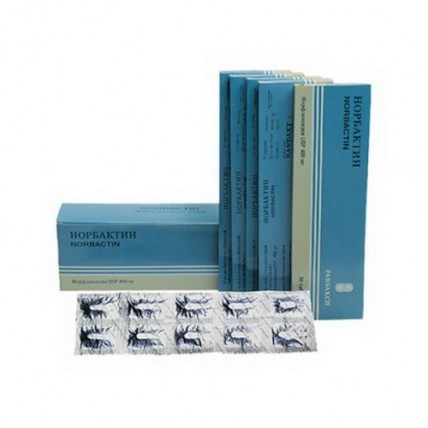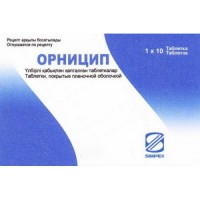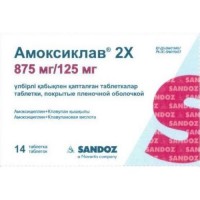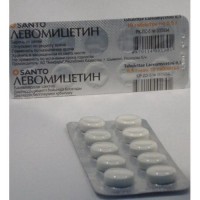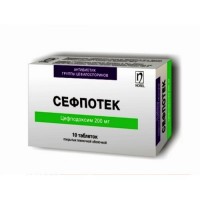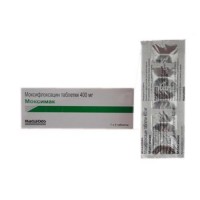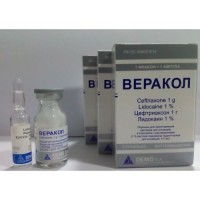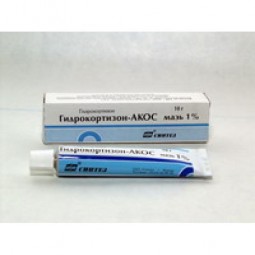Norbactin® (Norfloxacin) 400 mg, 10 coated tablets
- $18.00
The instruction for medical use
of Norbaktin® medicine
the Trade name
of Norbaktin®
the International unlicensed
name Norfloxacin Dosage Form
of the Tablet, film coated 400 mg
Structure
One tablet contains
active agent - norfloxacin of 408.12 mg (in terms of dry matter – 400 mg),
excipients: microcrystalline cellulose, sodium of a kroskarmelloz, starch corn, the talc purified silicon dioxide colloidal anhydrous, sodium lauryl sulfate, magnesium stearate,
a cover: a hydroksipropilmetiltsellyuloza, the macrogoal-400, talc purified the titan E171 dioxide.
The description
of the Tablet of oblong shape (kapleta), film coated white color, with the squeezed-out inscription NBT 400 from one party and with the line of a break on other party, with slanted edges.
Pharmacotherapeutic group
Antibacterial drugs - derivatives of a hinolon. Ftorkhinolona.
The code of automatic telephone exchange J01MA06
the Pharmacological
Pharmacokinetics Norfloxacin properties is quickly soaked up in digestive tract after oral administration, the absolute bioavailability of drug is 30-40%. After single dose in doses of 200 mg, 400 mg and 800 mg the peak concentration of 0.8, 1.5 and 2.4 mkg/ml respectively, are reached approximately in 1 h after reception. Intake of food and dairy products slows down absorption. Elimination half-life of norfloxacin makes 3 - 4 h, it can increase at patients with a renal failure. Steady concentration of norfloxacin are reached after 2 days of reception. 10 – 15% of the accepted dose of drug contact proteins of blood plasma. Norfloxacin reaches high concentrations in fabrics of an urogenital path, urine and bile.
It is removed by kidneys, by glomerular filtration and canalicular secretion. During 24 h from the moment of reception of 26-32% of a dose 5–8% are removed by kidneys in not changed look — in the form of metabolites, with bile about 30% of the accepted dose are allocated. At healthy elderly volunteers (age of 65-75 years) norfloxacin was removed from an organism more slowly because of reduced function of kidneys. After single dose of 400 mg of norfloxacin, average AUC and Cmax values were 9.8 (2.83) mkg. h/ml and 2.02 (0.77) mkg/ml respectively at healthy elderly volunteers. Extent of system influence was slightly higher, than at young adult volunteers (AUC of 6.4 mkg. h/ml and Cmax of 1.5 mkg/ml). Absorption of drug did not change. Elimination half-life of norfloxacin at elderly makes 4 hours.
Regulation of a dosage at elderly is not required. Correction of a dosage has to be carried out at elderly with reduced renal function. The norfloxacin pharmacokinetics at patients with clearance of creatinine more than 30 ml/min. / 1.73 to sq.m is similar to pharmacokinetics of healthy volunteers. At patients clearance of creatinine equal or less than 30 ml/min. / 1.73 sq.m, removal of norfloxacin through kidneys decreases and elimination half-life makes 6.5 hours. Such patients need to carry out dose adjustment.
rn urine can affect solubility of norfloxacin. Norfloxacin is least soluble in urine with rn 7.5, at the same time the solubility increases at higher values rn and decreases at lower values rn.
Table. The average concentration of norfloxacin in various liquids and fabrics measured in 1 - 4 hour after reception of two on 400 mg doses:
Fabric / liquid
Concentration
the Renal parenchyma
of 7.3 mkg/g
the Prostate
of 2.5 mkg/g
Semen
of 2.7 mkg/ml
the Small egg
of 1.6 mkg/g
the Uterus / neck
of 3.0 mkg/g
the Vagina
of 4.3 mkg/g
Fallopiyev of a pipe
of 1.9 mkg/g
Bile
of 6.9 mkg/ml (after two 200 mg of doses)
the Pharmacodynamics
Antimicrobial drug of group of ftorkhinolon of a broad spectrum of activity. Норбактин® has bactericidal effect. Suppressing DNK-girazu, breaks DNA superspiralling process. At the molecular level of three of specific actions are connected with norfloxacin in cells of colibacillus (Escherichia coli):
1) inhibition of ATP-dependent reaction of superspiralling of DNA catalyzed DNK-girazoy
2) braking of a relaxation of superspiral
DNA 3) stimulation of destruction of two-chain DNA.
Antimicrobial activity
in vitro Norfloxacin showed activity concerning a wide range of gram-positive and gram-negative aerobic bacteria. Fluorine atom in the 6th position provides the increased efficiency against gram-negative organisms, and the piperazin fragment in the 7th position is responsible for anti-pyocyanic activity.
It was proved that norfloxacin actively works for the majority of strains of the following microorganisms as in vitro, and at treatment of clinical infections.
Gram-positive aerobes: Enterococcus faecalis, Staphylococcus aureus, Staphylococcus epidermidis, Staphylococcus saprophyticus, Streptococcus agalactiae.
Gram-negative aerobes: Citrobacter freundii, Enterobacter aerogenes, Enterobacter cloacae, Escherichia coli, Klebsiella pneumoniae, Neisseria gonorrhoeae, Proteus mirabilis, Proteus vulgaris, Pseudomonas aeruginosa, Serratia marcescens.
Norfloxacin shows in vitro the minimum inhibiting concentration of £4 mkg/ml in relation to the majority (≥ 90%) strains of the following microorganisms, however safety and efficiency of norfloxacin at treatment of the clinical infections caused by these microorganisms were not established during adequate and well controlled clinical trials. Gram-negative aerobes: Citrobacter diversus, Edwardsiella tarda, Enterobacter agglomerans, Haemophilus ducreyi, Klebsiella oxytoca, Morganella morganii, Providencia alcalifaciens, Providencia rettgeri, Providencia stuartii, Pseudomonas fluorescens, Pseudomonas stutzeri. Other: Ureaplasma urealyticum Norfloxacin as a rule, is inactive concerning strict anaerobes. The resistance Resistance to norfloxacin owing to natural mutation of in vitro is an unusual occurrence (in the range from: 109 - 1012 cells). Resistant microorganisms appeared during treatment by norfloxacin less than at 1% of the patients taking the drug. Organisms at which development of the greatest resistance was observed: Pseudomonas aeruginosa, Klebsiella pneumoniae, Acinetobacter spp., Enterococcus spp. For this reason in the absence of satisfactory clinical reaction it is necessary to make repeated crops on flora and on sensitivity to antibiotics. The microorganisms resistant to effect of Acidum nalidixicum, as a rule, are susceptible to effect of norfloxacin in in vitro test tube, however, these organisms can have higher minimum inhibiting concentration to norfloxacin, than the strains susceptible to effect of Acidum nalidixicum. In general, the cross resistance between norfloxacin and other classes of antibacterial drugs is absent. Thus, norfloxacin can show activity concerning the specified microorganisms resistant to action of other antimicrobial means, including aminoglycosides, penicillin, cephalosporins, tetracyclines, macroleads, and streptocides, including combinations of sulfamethoxazole and Trimethoprimum. The antagonism was shown to in vitro between norfloxacin and nitrofurantoin.
Indications
Treatment of the infectious and inflammatory diseases caused by sensitive microorganisms:
- the uncomplicated infections of urinary tract (including cystitis) caused by Enterococcus faecalis, Escherichia coli, Klebsiella pneumoniae, Proteus mirabilis, Pseudomonas aeruginosa, Staphylococcus epidermidis, Staphylococcus saprophyticus, Citrobacter freundii, Enterobacter aerogenes, Enterobacter cloacae, Proteus vulgaris, Staphylococcus aureus or Streptococcus agalactiae
- the complicated infections of urinary tract caused by Enterococcus faecalis, Escherichia coli, Klebsiella pneumoniae, Proteus mirabilis, Pseudomonas aeruginosa or Serratia marcescens
- an infection of genitals (the uncomplicated gonococcal urethritis and a cervicitis caused by Neisseria gonorrhoeae) - the prostatitis caused by Escherichia coli
the Route of administration and doses
of Norbaktin® take inside, on an empty stomach (not less than for 1 h to or in 2 h after a meal or consumption of milk / dairy products). Not to break, not to crumble and not to chew, swallow of tablets entirely, washing down with enough liquid. The polyvitamins, drugs containing the iron or zinc, antacids containing magnesium and aluminum sukralfat or the drugs containing didanozin should not be accepted within 2 hours after reception of the tablets Norbaktin®.
The recommended dosages of Norbaktin®:
The infections
the Name Single Dose Frequency Duration Daily Dose Urinary Tract Uncomplicated Infections of urinary tract (cystitis) caused by Escherichia coli, Klebsiella pneumoniae or Proteus mirabilis
of 400 mg
each 12
hours 3 days
of 800 mg
Uncomplicated infections of urinary tract, caused by other microorganisms sensitive to effect of drug
of 400 mg
each 12
hours 7 - 10 days
of 800 mg
the Complicated infections of urinary tract
of 400 mg
each 12
hours 10 - 21 days
of 800 mg
of the Infection of genitals
Uncomplicated gonorrhea
of 800 mg
once
1 day
of 800 mg
Prostatitis
Sharp or chronic
400 mg
each 12
hours 28 days
of 800 mg
the Renal failure
of Norbaktin® it can be used for treatment of infections of urinary tract at patients with a renal failure. Patients with clearance of creatinine have 30 ml/min. / 1.73м2 or less recommended dose makes 1 tablet 400 mg during the time stated above once a day. At this dose the concentration of drug in urine exceeds the minimum inhibiting concentration for the majority of the causative organisms of an uric path sensitive to norfloxacin, even in case the clearance of creatinine is less than 10 ml/min. / 1.73 sq.m.
Elderly patients
At treatment of infections of urinary tract at elderly patients with clearance of creatinine of 30 ml/min. / 1.73 sq.m or less, it is necessary to take the drug on 400 mg once a day.
Side effects
Often
- rash
- a skin itching, fotosensibilization / reactions of phototoxicity
it is rare
- reactions of hypersensitivity, including anaphylactoid reactions, a Quincke's disease, an asthma, a vasculitis, urticaria
- arthritis, joint pains, muscle pains, a tendinitis, a rupture of sinews, aggravation of a myasthenia
- a loss of appetite, a dysphagy, bitterness in a mouth, nausea, vomiting, an abdominal pain, diarrhea
- hepatitis, jaundice, including cholestatic jaundice and increase in activity of liver enzymes, pancreatitis, stomatitis
- headaches, dizziness, unconscious states, insomnia, hallucinations, spasms, a myoclonus, a tremor
- a neutropenia, a leukopenia, an agranulocytosis, hemolytic anemia, dehydrogenase glyukozo-6-phosphate, the eosinophilia, thrombocytopenia sometimes connected with a shortcoming
- an agranulocytosis, an albuminuria, a kandiduriya, a crystalluria, a cylindruria
- a hyperglycemia, increase in cholesterol in blood, increase in potassium in blood serum, increase in triglycerides in blood serum, a hamaturia, a symptomatic hypoglycemia
- postural hypotension, tachycardia, arrhythmias, lengthening of a prothrombin time
- vaginal candidiasis
Very seldom
- a toxic epidermal necrolysis, Stephens-Johnson's syndrome and an erythema, exfoliative dermatitis
- the extended QT interval on the ECG and ventricular arrhythmias, including torsade de pointes of ventricles
- peripheral neuropathy, polyneuropathy, including a syndrome to Giyena-Barra, the ataxy, paresthesia, a hypesthesia, mental disturbances, including psychotic reactions, confusion of consciousness, a spasm
- interstitial nephrite, a renal failure, urethral bleedings
- a liver failure, pseudomembranous colitis
- a hearing loss, sonitus, a diplopia, a disorder of vision,
the Contraindication food faddism
- hypersensitivity to norfloxacin or other drugs from group of ftorkhinolon
- deficit dehydrogenase glucose-6-phosphate
- a heavy renal failure
- the tendinitis, ruptures of sinews in the anamnesis connected with use of norfloxacin or any other drug of group of hinolon
- pregnancy and the period of a lactation
- children's and teenage age up to 18 years
Medicinal interactions
of Hinolona, including norfloxacin, inhibit CYP1A2 in vitro. Interaction with drugs which are acquired by means of CYP1A2, (for example: caffeine, clozapine, ropinirol, takrin, theophylline, tizanidin) can lead to increase in concentration of drug in blood, even at reception in usual doses. The patients accepting any of the specified drugs along with norfloxacin have to be under careful observation.
The concomitant use of a tizanidin and norfloxacin is not recommended. The increased theophylline levels in blood plasma were registered at the accompanying reception of a hinolon. Cases of emergence of the side effects connected with theophylline at patients with the accompanying intake of norfloxacin and theophylline were registered. It is necessary to control theophylline level in blood plasma, and doses of norfloxacin have to be adjusted in case of need. Increase in level of cyclosporine in blood serum was registered at a concomitant use of cyclosporine and norfloxacin. Thus, cyclosporine levels in blood serum have to be checked, and doses of cyclosporine are modified as appropriate at a concomitant use of these drugs. Simultaneous use with the medicines having potential ability to reduce arterial blood pressure can cause sharp hypotension. Hinolona, including norfloxacin, effect of oral anticoagulants, including warfarin or its derivatives or similar substances can strengthen. At a concomitant use of these drugs it is necessary to watch strictly a prothrombin time or other tests on coagulation. The accompanying reception of hinolon, including norfloxacin, with Glyburidum/glibenclamide (sulphonylurea) in rare instances led to a heavy hypoglycemia. Thus, control of level of sugar of blood is recommended to be carried out at a concomitant use of these medicines. The lowered norfloxacin discharge with urine was registered at the accompanying reception of a probenetsid and norfloxacin. The accompanying use nitrofurantoin is not recommended as nitrofurantoin can counteract antibacterial effect of norfloxacin in uric ways. Polyvitamins, or other drugs containing iron or zinc, antacids or sukralfat should not be accepted along with norfloxacin or within 2 hours from the moment of its reception as they can interfere with absorption that leads to decrease in level of norfloxacin in blood serum and in urine. Chewing / buffer tablets with antacids or didanoziny, or pediatric powder for use in the form of solution for oral administration it is not necessary to accept along with norfloxacin or within 2 hours from the moment of its reception as they can interfere with absorption that leads to decrease in level of norfloxacin in blood serum and in urine. It was proved that some hinolona interact with caffeine metabolism. At joint intake of norfloxacin with the products containing caffeine the concentration of caffeine in blood plasma can increase. The accompanying intake of non-steroidal anti-inflammatory drugs (NPVP) from hinolona, including with norfloxacin, can increase risk of stimulation of central nervous system and appearance of convulsive attacks. Thus, norfloxacin has to be used with care for treatment of the persons accepting at the same time NPVP. It is necessary to avoid the accompanying reception of hinolon and a fenbufen.
Special indications
of Tendinopatii / rupture of sinews: ftorkhinolona, including norfloxacin, are connected with the increased risk of developing a tendinitis and a rupture of a sinew at various age. This risk increases at patients is more senior than 60 years accepting corticosteroids and at patients with organ transplantation. At emergence of the first symptoms of pain in sinews, swellings or inflammations, it is necessary to stop reception of a ftorkhinolon, to avoid physical activity and also to contact immediately the doctor for replacement of antibacterial drug.
Spasms: hinolona can also stimulate the central nervous system (CNS) that can lead to emergence of a tremor, concern, dizziness, confusion of consciousness, hallucinations and spasms. At emergence of the specified reactions at the patients receiving norfloxacin, administration of drug has to be stopped, and the appropriate measures are taken. Norfloxacin should be applied with care at patients with the known or suspected central nervous system disorders, such as heavy cerebral atherosclerosis, epilepsy and other factors which contribute to appearance of spasms.
Hypersensitivity reactions: cases heavy and sometimes fatal hypersensitivity (anaphylactic) reactions some right after reception of the first dose, at the patients accepting hinolona were registered including norfloxacin. Some reactions were followed by cardiovascular insufficiency, a loss of consciousness, pricking, edema of laryngeal or face, an asthma, a small tortoiseshell and an itching. At emergence of allergic reaction to norfloxacin it is necessary to stop administration of drug. Heavy acute reactions of hypersensitivity demand immediate use of emergency treatment.
Others were seldom noted heavy and sometimes fatal cases owing to hypersensitivity at the patients receiving hinolonovy therapy including norfloxacin. These reactions usually come after introduction of repeated doses. Clinical manifestations can include one or more following signs: fever, rash or heavy dermatological reactions (toxic epidermal necrolysis, Stephens-Johnson's syndrome), a vasculitis, an arthralgia, myalgia, a serum disease, an allergic pneumonitis, interstitial nephrite, an acute renal failure, hepatitis, jaundice, acute necrotic hepatitis or a liver failure, anemia, including hemolytic and aplastic anemia, thrombocytopenia, a Werlhof's disease, a leukopenia, an agranulocytosis, a pancytopenia and/or other hematologic deviations.
Klostridium the diffitsile-associated diarrhea: clostridium difficile-associated diarrhea (CDAD) was noted when using almost all antibacterial drugs, including norfloxacin, and can be located on severity from moderate diarrhea to fatal colitis. Treatment by antibacterial agents leads to modification of normal flora of a large intestine and can lead to the strengthened growth of clostridiums. It is necessary to collect carefully the anamnesis of a disease as CDAD, as we know, occurs more than two months later after use of antibacterial drugs. If it is suspected or the diagnosis pseudomembranous colitis is established, it is necessary to cancel norfloxacin and to begin the corresponding treatment.
Peripheral neuropathy: seldom the cases of a touch or touch and motive axonal polyneuropathy leading to paresthesia, disturbance of sensitivity including to decrease in sensitivity, and weakness met at the patients receiving hinolona including norfloxacin. It is necessary to stop norfloxacin use, in case of emergence in patients of symptoms of neuropathy, including pain, burning sensation, feeling of pricking, numbness and/or weakness in extremities.
Treatment of syphilis: the efficiency of norfloxacin was not proved at treatment of syphilis. The germicides used in high doses during the short span for treatment of gonorrhea can mask or hide symptoms of development of syphilis. All patients having gonorrhea have to pass a serological test for syphilis. The patients receiving treatment by norfloxacin have to pass a repeated serological test for syphilis in 3 months.
Crystalluria: the crystalluria is not noted at administration of drug in a dose 400 mg twice a day. As a precautionary measure, the daily recommended dose should not be exceeded and the patient has to drink enough liquid for ensuring appropriate level of hydration and adequate amount of the emitted urine.
Photosensitivity / fototoksichnost: reactions of photosensitivity / phototoxicity, last of which can be shown in the form of reactions to a sunblister (e.g. a burn, an erythema, bubbles, blisters, hypostases), including the areas which were affected by light (generally the person, area of a decollete, extensor surfaces of forearms, the back of brushes), can be connected with use of hinolon after exposure to influence of the sun or ultraviolet radiation. Therefore it is necessary to avoid exposure to excessive influence of these light sources. It is necessary to interrupt medicinal therapy, in case of phototoxicity.
Myasthenia: hinolona, including norfloxacin, can aggravate signs of a myasthenia and result in life-threatening weakness of respiratory muscles. It is necessary to show care when using ftorkhinolon, including norfloxacin, for treatment of the patients suffering from a myasthenia.
Disturbances of warm activity: as well as at intake of other drugs which can increase QT interval by the ECG it is necessary to show care at intake of norfloxacin for treatment of the patients suffering from a hypopotassemia, bradycardia or at patients who undergo simultaneous treatment by antiarrhytmic drugs of the class IA or class III. Some ftorkhinolona, including norfloxacin, have to be used with care for treatment of the patients applying tsisaprid, erythromycin, neuroleptics, tricyclic antidepressants or in the personal or family anamnesis of which there were cases of extension of an interval of QT on the ECG.
Prescribing of norfloxacin in the absence of the proved bacterial infection or preventive indications will not bring benefit to the patient, and will increase risk of development of drug resistance of bacteria.
Elderly Elderly patients are exposed to the increased risk of developing heavy disorders of sinews, including a rupture of a sinew at reception of ftorkhinolon, such as norfloxacin. This risk increases at the patients receiving the accompanying treatment by corticosteroids. The tendinitis or a rupture of a sinew can occur in time or after the end of therapy, cases of developing of a disease within several months after completion of treatment of a ftorkhinolonama were registered. Prescribing of norfloxacin has to be made for treatment of the elderly patients who are especially accepting corticosteroids with care. Patients need to report about the specified potential side reactions and to recommend to stop intake of norfloxacin and to contact the doctor at emergence of any symptoms of a tendinitis or a rupture of a sinew.
Features of influence of medicine on ability to run the vehicle or potentially dangerous mechanisms Norfloxacin can cause dizziness, a preunconscious state and, therefore, patients have to be informed on a possibility of such reaction to norfloxacin before running vehicles potentially dangerous mechanisms or to be engaged in activity, requiring special attention and speed of psychomotor reactions.
Overdose
Symptoms: dizziness, nausea, vomiting
Treatment: to cause vomiting or to wash out a stomach. The patient has to be under careful observation. Symptomatic and maintenance therapy is carried out. It is necessary to accept a large amount of water.
The form of release and packing
On 10 tablets place in blister strip packaging (blister) from a transparent film of PVH/PVDH and aluminum foil or in planimetric bezjyacheykovy packing from aluminum foil (strip).
On 1 or 10 blister strip packagings (blisters) or on 1 or 10 planimetric bezjyacheykovy packs (strips) together with the instruction on medical
to the prima Razvernut
of Norbaktin® medicine
the Trade name
of Norbaktin®
the International unlicensed
name Norfloxacin Dosage Form
of the Tablet, film coated 400 mg
Structure
One tablet contains
active agent - norfloxacin of 408.12 mg (in terms of dry matter – 400 mg),
excipients: microcrystalline cellulose, sodium of a kroskarmelloz, starch corn, the talc purified silicon dioxide colloidal anhydrous, sodium lauryl sulfate, magnesium stearate,
a cover: a hydroksipropilmetiltsellyuloza, the macrogoal-400, talc purified the titan E171 dioxide.
The description
of the Tablet of oblong shape (kapleta), film coated white color, with the squeezed-out inscription NBT 400 from one party and with the line of a break on other party, with slanted edges.
Pharmacotherapeutic group
Antibacterial drugs - derivatives of a hinolon. Ftorkhinolona.
The code of automatic telephone exchange J01MA06
the Pharmacological
Pharmacokinetics Norfloxacin properties is quickly soaked up in digestive tract after oral administration, the absolute bioavailability of drug is 30-40%. After single dose in doses of 200 mg, 400 mg and 800 mg the peak concentration of 0.8, 1.5 and 2.4 mkg/ml respectively, are reached approximately in 1 h after reception. Intake of food and dairy products slows down absorption. Elimination half-life of norfloxacin makes 3 - 4 h, it can increase at patients with a renal failure. Steady concentration of norfloxacin are reached after 2 days of reception. 10 – 15% of the accepted dose of drug contact proteins of blood plasma. Norfloxacin reaches high concentrations in fabrics of an urogenital path, urine and bile.
It is removed by kidneys, by glomerular filtration and canalicular secretion. During 24 h from the moment of reception of 26-32% of a dose 5–8% are removed by kidneys in not changed look — in the form of metabolites, with bile about 30% of the accepted dose are allocated. At healthy elderly volunteers (age of 65-75 years) norfloxacin was removed from an organism more slowly because of reduced function of kidneys. After single dose of 400 mg of norfloxacin, average AUC and Cmax values were 9.8 (2.83) mkg. h/ml and 2.02 (0.77) mkg/ml respectively at healthy elderly volunteers. Extent of system influence was slightly higher, than at young adult volunteers (AUC of 6.4 mkg. h/ml and Cmax of 1.5 mkg/ml). Absorption of drug did not change. Elimination half-life of norfloxacin at elderly makes 4 hours.
Regulation of a dosage at elderly is not required. Correction of a dosage has to be carried out at elderly with reduced renal function. The norfloxacin pharmacokinetics at patients with clearance of creatinine more than 30 ml/min. / 1.73 to sq.m is similar to pharmacokinetics of healthy volunteers. At patients clearance of creatinine equal or less than 30 ml/min. / 1.73 sq.m, removal of norfloxacin through kidneys decreases and elimination half-life makes 6.5 hours. Such patients need to carry out dose adjustment.
rn urine can affect solubility of norfloxacin. Norfloxacin is least soluble in urine with rn 7.5, at the same time the solubility increases at higher values rn and decreases at lower values rn.
Table. The average concentration of norfloxacin in various liquids and fabrics measured in 1 - 4 hour after reception of two on 400 mg doses:
Fabric / liquid
Concentration
the Renal parenchyma
of 7.3 mkg/g
the Prostate
of 2.5 mkg/g
Semen
of 2.7 mkg/ml
the Small egg
of 1.6 mkg/g
the Uterus / neck
of 3.0 mkg/g
the Vagina
of 4.3 mkg/g
Fallopiyev of a pipe
of 1.9 mkg/g
Bile
of 6.9 mkg/ml (after two 200 mg of doses)
the Pharmacodynamics
Antimicrobial drug of group of ftorkhinolon of a broad spectrum of activity. Норбактин® has bactericidal effect. Suppressing DNK-girazu, breaks DNA superspiralling process. At the molecular level of three of specific actions are connected with norfloxacin in cells of colibacillus (Escherichia coli):
1) inhibition of ATP-dependent reaction of superspiralling of DNA catalyzed DNK-girazoy
2) braking of a relaxation of superspiral
DNA 3) stimulation of destruction of two-chain DNA.
Antimicrobial activity
in vitro Norfloxacin showed activity concerning a wide range of gram-positive and gram-negative aerobic bacteria. Fluorine atom in the 6th position provides the increased efficiency against gram-negative organisms, and the piperazin fragment in the 7th position is responsible for anti-pyocyanic activity.
It was proved that norfloxacin actively works for the majority of strains of the following microorganisms as in vitro, and at treatment of clinical infections.
Gram-positive aerobes: Enterococcus faecalis, Staphylococcus aureus, Staphylococcus epidermidis, Staphylococcus saprophyticus, Streptococcus agalactiae.
Gram-negative aerobes: Citrobacter freundii, Enterobacter aerogenes, Enterobacter cloacae, Escherichia coli, Klebsiella pneumoniae, Neisseria gonorrhoeae, Proteus mirabilis, Proteus vulgaris, Pseudomonas aeruginosa, Serratia marcescens.
Norfloxacin shows in vitro the minimum inhibiting concentration of £4 mkg/ml in relation to the majority (≥ 90%) strains of the following microorganisms, however safety and efficiency of norfloxacin at treatment of the clinical infections caused by these microorganisms were not established during adequate and well controlled clinical trials. Gram-negative aerobes: Citrobacter diversus, Edwardsiella tarda, Enterobacter agglomerans, Haemophilus ducreyi, Klebsiella oxytoca, Morganella morganii, Providencia alcalifaciens, Providencia rettgeri, Providencia stuartii, Pseudomonas fluorescens, Pseudomonas stutzeri. Other: Ureaplasma urealyticum Norfloxacin as a rule, is inactive concerning strict anaerobes. The resistance Resistance to norfloxacin owing to natural mutation of in vitro is an unusual occurrence (in the range from: 109 - 1012 cells). Resistant microorganisms appeared during treatment by norfloxacin less than at 1% of the patients taking the drug. Organisms at which development of the greatest resistance was observed: Pseudomonas aeruginosa, Klebsiella pneumoniae, Acinetobacter spp., Enterococcus spp. For this reason in the absence of satisfactory clinical reaction it is necessary to make repeated crops on flora and on sensitivity to antibiotics. The microorganisms resistant to effect of Acidum nalidixicum, as a rule, are susceptible to effect of norfloxacin in in vitro test tube, however, these organisms can have higher minimum inhibiting concentration to norfloxacin, than the strains susceptible to effect of Acidum nalidixicum. In general, the cross resistance between norfloxacin and other classes of antibacterial drugs is absent. Thus, norfloxacin can show activity concerning the specified microorganisms resistant to action of other antimicrobial means, including aminoglycosides, penicillin, cephalosporins, tetracyclines, macroleads, and streptocides, including combinations of sulfamethoxazole and Trimethoprimum. The antagonism was shown to in vitro between norfloxacin and nitrofurantoin.
Indications
Treatment of the infectious and inflammatory diseases caused by sensitive microorganisms:
- the uncomplicated infections of urinary tract (including cystitis) caused by Enterococcus faecalis, Escherichia coli, Klebsiella pneumoniae, Proteus mirabilis, Pseudomonas aeruginosa, Staphylococcus epidermidis, Staphylococcus saprophyticus, Citrobacter freundii, Enterobacter aerogenes, Enterobacter cloacae, Proteus vulgaris, Staphylococcus aureus or Streptococcus agalactiae
- the complicated infections of urinary tract caused by Enterococcus faecalis, Escherichia coli, Klebsiella pneumoniae, Proteus mirabilis, Pseudomonas aeruginosa or Serratia marcescens
- an infection of genitals (the uncomplicated gonococcal urethritis and a cervicitis caused by Neisseria gonorrhoeae) - the prostatitis caused by Escherichia coli
the Route of administration and doses
of Norbaktin® take inside, on an empty stomach (not less than for 1 h to or in 2 h after a meal or consumption of milk / dairy products). Not to break, not to crumble and not to chew, swallow of tablets entirely, washing down with enough liquid. The polyvitamins, drugs containing the iron or zinc, antacids containing magnesium and aluminum sukralfat or the drugs containing didanozin should not be accepted within 2 hours after reception of the tablets Norbaktin®.
The recommended dosages of Norbaktin®:
The infections
the Name Single Dose Frequency Duration Daily Dose Urinary Tract Uncomplicated Infections of urinary tract (cystitis) caused by Escherichia coli, Klebsiella pneumoniae or Proteus mirabilis
of 400 mg
each 12
hours 3 days
of 800 mg
Uncomplicated infections of urinary tract, caused by other microorganisms sensitive to effect of drug
of 400 mg
each 12
hours 7 - 10 days
of 800 mg
the Complicated infections of urinary tract
of 400 mg
each 12
hours 10 - 21 days
of 800 mg
of the Infection of genitals
Uncomplicated gonorrhea
of 800 mg
once
1 day
of 800 mg
Prostatitis
Sharp or chronic
400 mg
each 12
hours 28 days
of 800 mg
the Renal failure
of Norbaktin® it can be used for treatment of infections of urinary tract at patients with a renal failure. Patients with clearance of creatinine have 30 ml/min. / 1.73м2 or less recommended dose makes 1 tablet 400 mg during the time stated above once a day. At this dose the concentration of drug in urine exceeds the minimum inhibiting concentration for the majority of the causative organisms of an uric path sensitive to norfloxacin, even in case the clearance of creatinine is less than 10 ml/min. / 1.73 sq.m.
Elderly patients
At treatment of infections of urinary tract at elderly patients with clearance of creatinine of 30 ml/min. / 1.73 sq.m or less, it is necessary to take the drug on 400 mg once a day.
Side effects
Often
- rash
- a skin itching, fotosensibilization / reactions of phototoxicity
it is rare
- reactions of hypersensitivity, including anaphylactoid reactions, a Quincke's disease, an asthma, a vasculitis, urticaria
- arthritis, joint pains, muscle pains, a tendinitis, a rupture of sinews, aggravation of a myasthenia
- a loss of appetite, a dysphagy, bitterness in a mouth, nausea, vomiting, an abdominal pain, diarrhea
- hepatitis, jaundice, including cholestatic jaundice and increase in activity of liver enzymes, pancreatitis, stomatitis
- headaches, dizziness, unconscious states, insomnia, hallucinations, spasms, a myoclonus, a tremor
- a neutropenia, a leukopenia, an agranulocytosis, hemolytic anemia, dehydrogenase glyukozo-6-phosphate, the eosinophilia, thrombocytopenia sometimes connected with a shortcoming
- an agranulocytosis, an albuminuria, a kandiduriya, a crystalluria, a cylindruria
- a hyperglycemia, increase in cholesterol in blood, increase in potassium in blood serum, increase in triglycerides in blood serum, a hamaturia, a symptomatic hypoglycemia
- postural hypotension, tachycardia, arrhythmias, lengthening of a prothrombin time
- vaginal candidiasis
Very seldom
- a toxic epidermal necrolysis, Stephens-Johnson's syndrome and an erythema, exfoliative dermatitis
- the extended QT interval on the ECG and ventricular arrhythmias, including torsade de pointes of ventricles
- peripheral neuropathy, polyneuropathy, including a syndrome to Giyena-Barra, the ataxy, paresthesia, a hypesthesia, mental disturbances, including psychotic reactions, confusion of consciousness, a spasm
- interstitial nephrite, a renal failure, urethral bleedings
- a liver failure, pseudomembranous colitis
- a hearing loss, sonitus, a diplopia, a disorder of vision,
the Contraindication food faddism
- hypersensitivity to norfloxacin or other drugs from group of ftorkhinolon
- deficit dehydrogenase glucose-6-phosphate
- a heavy renal failure
- the tendinitis, ruptures of sinews in the anamnesis connected with use of norfloxacin or any other drug of group of hinolon
- pregnancy and the period of a lactation
- children's and teenage age up to 18 years
Medicinal interactions
of Hinolona, including norfloxacin, inhibit CYP1A2 in vitro. Interaction with drugs which are acquired by means of CYP1A2, (for example: caffeine, clozapine, ropinirol, takrin, theophylline, tizanidin) can lead to increase in concentration of drug in blood, even at reception in usual doses. The patients accepting any of the specified drugs along with norfloxacin have to be under careful observation.
The concomitant use of a tizanidin and norfloxacin is not recommended. The increased theophylline levels in blood plasma were registered at the accompanying reception of a hinolon. Cases of emergence of the side effects connected with theophylline at patients with the accompanying intake of norfloxacin and theophylline were registered. It is necessary to control theophylline level in blood plasma, and doses of norfloxacin have to be adjusted in case of need. Increase in level of cyclosporine in blood serum was registered at a concomitant use of cyclosporine and norfloxacin. Thus, cyclosporine levels in blood serum have to be checked, and doses of cyclosporine are modified as appropriate at a concomitant use of these drugs. Simultaneous use with the medicines having potential ability to reduce arterial blood pressure can cause sharp hypotension. Hinolona, including norfloxacin, effect of oral anticoagulants, including warfarin or its derivatives or similar substances can strengthen. At a concomitant use of these drugs it is necessary to watch strictly a prothrombin time or other tests on coagulation. The accompanying reception of hinolon, including norfloxacin, with Glyburidum/glibenclamide (sulphonylurea) in rare instances led to a heavy hypoglycemia. Thus, control of level of sugar of blood is recommended to be carried out at a concomitant use of these medicines. The lowered norfloxacin discharge with urine was registered at the accompanying reception of a probenetsid and norfloxacin. The accompanying use nitrofurantoin is not recommended as nitrofurantoin can counteract antibacterial effect of norfloxacin in uric ways. Polyvitamins, or other drugs containing iron or zinc, antacids or sukralfat should not be accepted along with norfloxacin or within 2 hours from the moment of its reception as they can interfere with absorption that leads to decrease in level of norfloxacin in blood serum and in urine. Chewing / buffer tablets with antacids or didanoziny, or pediatric powder for use in the form of solution for oral administration it is not necessary to accept along with norfloxacin or within 2 hours from the moment of its reception as they can interfere with absorption that leads to decrease in level of norfloxacin in blood serum and in urine. It was proved that some hinolona interact with caffeine metabolism. At joint intake of norfloxacin with the products containing caffeine the concentration of caffeine in blood plasma can increase. The accompanying intake of non-steroidal anti-inflammatory drugs (NPVP) from hinolona, including with norfloxacin, can increase risk of stimulation of central nervous system and appearance of convulsive attacks. Thus, norfloxacin has to be used with care for treatment of the persons accepting at the same time NPVP. It is necessary to avoid the accompanying reception of hinolon and a fenbufen.
Special indications
of Tendinopatii / rupture of sinews: ftorkhinolona, including norfloxacin, are connected with the increased risk of developing a tendinitis and a rupture of a sinew at various age. This risk increases at patients is more senior than 60 years accepting corticosteroids and at patients with organ transplantation. At emergence of the first symptoms of pain in sinews, swellings or inflammations, it is necessary to stop reception of a ftorkhinolon, to avoid physical activity and also to contact immediately the doctor for replacement of antibacterial drug.
Spasms: hinolona can also stimulate the central nervous system (CNS) that can lead to emergence of a tremor, concern, dizziness, confusion of consciousness, hallucinations and spasms. At emergence of the specified reactions at the patients receiving norfloxacin, administration of drug has to be stopped, and the appropriate measures are taken. Norfloxacin should be applied with care at patients with the known or suspected central nervous system disorders, such as heavy cerebral atherosclerosis, epilepsy and other factors which contribute to appearance of spasms.
Hypersensitivity reactions: cases heavy and sometimes fatal hypersensitivity (anaphylactic) reactions some right after reception of the first dose, at the patients accepting hinolona were registered including norfloxacin. Some reactions were followed by cardiovascular insufficiency, a loss of consciousness, pricking, edema of laryngeal or face, an asthma, a small tortoiseshell and an itching. At emergence of allergic reaction to norfloxacin it is necessary to stop administration of drug. Heavy acute reactions of hypersensitivity demand immediate use of emergency treatment.
Others were seldom noted heavy and sometimes fatal cases owing to hypersensitivity at the patients receiving hinolonovy therapy including norfloxacin. These reactions usually come after introduction of repeated doses. Clinical manifestations can include one or more following signs: fever, rash or heavy dermatological reactions (toxic epidermal necrolysis, Stephens-Johnson's syndrome), a vasculitis, an arthralgia, myalgia, a serum disease, an allergic pneumonitis, interstitial nephrite, an acute renal failure, hepatitis, jaundice, acute necrotic hepatitis or a liver failure, anemia, including hemolytic and aplastic anemia, thrombocytopenia, a Werlhof's disease, a leukopenia, an agranulocytosis, a pancytopenia and/or other hematologic deviations.
Klostridium the diffitsile-associated diarrhea: clostridium difficile-associated diarrhea (CDAD) was noted when using almost all antibacterial drugs, including norfloxacin, and can be located on severity from moderate diarrhea to fatal colitis. Treatment by antibacterial agents leads to modification of normal flora of a large intestine and can lead to the strengthened growth of clostridiums. It is necessary to collect carefully the anamnesis of a disease as CDAD, as we know, occurs more than two months later after use of antibacterial drugs. If it is suspected or the diagnosis pseudomembranous colitis is established, it is necessary to cancel norfloxacin and to begin the corresponding treatment.
Peripheral neuropathy: seldom the cases of a touch or touch and motive axonal polyneuropathy leading to paresthesia, disturbance of sensitivity including to decrease in sensitivity, and weakness met at the patients receiving hinolona including norfloxacin. It is necessary to stop norfloxacin use, in case of emergence in patients of symptoms of neuropathy, including pain, burning sensation, feeling of pricking, numbness and/or weakness in extremities.
Treatment of syphilis: the efficiency of norfloxacin was not proved at treatment of syphilis. The germicides used in high doses during the short span for treatment of gonorrhea can mask or hide symptoms of development of syphilis. All patients having gonorrhea have to pass a serological test for syphilis. The patients receiving treatment by norfloxacin have to pass a repeated serological test for syphilis in 3 months.
Crystalluria: the crystalluria is not noted at administration of drug in a dose 400 mg twice a day. As a precautionary measure, the daily recommended dose should not be exceeded and the patient has to drink enough liquid for ensuring appropriate level of hydration and adequate amount of the emitted urine.
Photosensitivity / fototoksichnost: reactions of photosensitivity / phototoxicity, last of which can be shown in the form of reactions to a sunblister (e.g. a burn, an erythema, bubbles, blisters, hypostases), including the areas which were affected by light (generally the person, area of a decollete, extensor surfaces of forearms, the back of brushes), can be connected with use of hinolon after exposure to influence of the sun or ultraviolet radiation. Therefore it is necessary to avoid exposure to excessive influence of these light sources. It is necessary to interrupt medicinal therapy, in case of phototoxicity.
Myasthenia: hinolona, including norfloxacin, can aggravate signs of a myasthenia and result in life-threatening weakness of respiratory muscles. It is necessary to show care when using ftorkhinolon, including norfloxacin, for treatment of the patients suffering from a myasthenia.
Disturbances of warm activity: as well as at intake of other drugs which can increase QT interval by the ECG it is necessary to show care at intake of norfloxacin for treatment of the patients suffering from a hypopotassemia, bradycardia or at patients who undergo simultaneous treatment by antiarrhytmic drugs of the class IA or class III. Some ftorkhinolona, including norfloxacin, have to be used with care for treatment of the patients applying tsisaprid, erythromycin, neuroleptics, tricyclic antidepressants or in the personal or family anamnesis of which there were cases of extension of an interval of QT on the ECG.
Prescribing of norfloxacin in the absence of the proved bacterial infection or preventive indications will not bring benefit to the patient, and will increase risk of development of drug resistance of bacteria.
Elderly Elderly patients are exposed to the increased risk of developing heavy disorders of sinews, including a rupture of a sinew at reception of ftorkhinolon, such as norfloxacin. This risk increases at the patients receiving the accompanying treatment by corticosteroids. The tendinitis or a rupture of a sinew can occur in time or after the end of therapy, cases of developing of a disease within several months after completion of treatment of a ftorkhinolonama were registered. Prescribing of norfloxacin has to be made for treatment of the elderly patients who are especially accepting corticosteroids with care. Patients need to report about the specified potential side reactions and to recommend to stop intake of norfloxacin and to contact the doctor at emergence of any symptoms of a tendinitis or a rupture of a sinew.
Features of influence of medicine on ability to run the vehicle or potentially dangerous mechanisms Norfloxacin can cause dizziness, a preunconscious state and, therefore, patients have to be informed on a possibility of such reaction to norfloxacin before running vehicles potentially dangerous mechanisms or to be engaged in activity, requiring special attention and speed of psychomotor reactions.
Overdose
Symptoms: dizziness, nausea, vomiting
Treatment: to cause vomiting or to wash out a stomach. The patient has to be under careful observation. Symptomatic and maintenance therapy is carried out. It is necessary to accept a large amount of water.
The form of release and packing
On 10 tablets place in blister strip packaging (blister) from a transparent film of PVH/PVDH and aluminum foil or in planimetric bezjyacheykovy packing from aluminum foil (strip).
On 1 or 10 blister strip packagings (blisters) or on 1 or 10 planimetric bezjyacheykovy packs (strips) together with the instruction on medical
to the prima Razvernut
